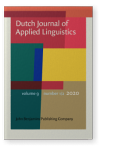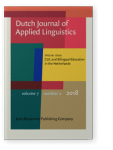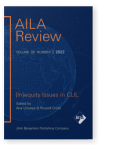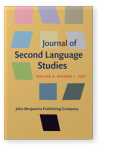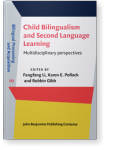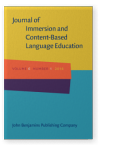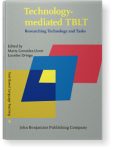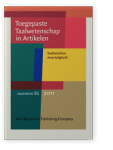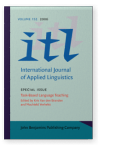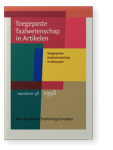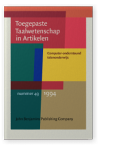Rick de Graaff
List of John Benjamins publications for which Rick de Graaff plays a role.
Journal
Title
CLIL and Bilingual Education in the Netherlands
Edited by Tessa Mearns and Rick de Graaff
Special issue of Dutch Journal of Applied Linguistics 7:2 (2018) vi, 158 pp.
Subjects Applied linguistics | Language acquisition | Language teaching | Multilingualism
2022 Inclusive CLIL: Pre-vocational pupils’ target language oral proficiency, fluency, and Willingness to Communicate (In)equity Issues in CLIL, Llinares, Ana and Russell Cross (eds.), pp. 321–350 | Article
Bilingual education using a Content and Language Integrated Learning (CLIL) approach seems in many contexts to select or attract the more able and more academically-inclined pupils, or only be available to pupils in higher academic secondary streams. Positive effects of CLIL for target language… read more
2021 Improving second language reading comprehension through reading strategies: A meta-analysis of L2 reading strategy interventions Journal of Second Language Studies 4:1, pp. 154–192 | Article
Effective readers consciously or unconsciously use reading strategies to help them process information on what they read. All readers can benefit from reading strategy instruction but, empirical research on which strategies are effective is lacking. Less is known about reading strategy… read more
2020 Chapter 8. Current developments in bilingual primary education in the Netherlands Child Bilingualism and Second Language Learning: Multidisciplinary perspectives, Li, Fangfang, Karen E. Pollock and Robbin Gibb (eds.), pp. 137–166 | Chapter
This contribution addresses two studies of the processes and outcomes of English as a foreign language (EFL) in Dutch primary education. Firstly, this article describes a preliminary study of the learning outcomes at the end of primary education, comparing pupils’ language proficiency after… read more
2018 Attitudinal factors and the intention to learn English in pre-vocational secondary bilingual and mainstream education CLIL and Bilingual Education in the Netherlands, Mearns, Tessa and Rick de Graaff (eds.), pp. 203–226 | Article
The effect of bilingual education (BE) on the attitude towards learning English of pupils in the first three years of pre-vocational secondary education in the Netherlands (n = 488) was investigated. Contrary to several other BE/CLIL studies, in the present study pupils choosing for a bilingual… read more
2018 Bilingual education and CLIL in the Netherlands: The paradigm and the pedagogy CLIL and Bilingual Education in the Netherlands, Mearns, Tessa and Rick de Graaff (eds.), pp. 122–128 | Introduction
The Netherlands is often held up an example of a ‘success story’ in terms of practices and research regarding the teaching and learning of subject content in a second language (de Graaff & van Wilgenburg, 2015; Pérez-Cañado, 2012). Nearly 30 years after its initial beginnings, bilingual… read more
2018 Bucking the trend? Motivational differences between boys and girls who opt in or out of bilingual education Journal of Immersion and Content-Based Language Education 6:1, pp. 1–26 | Article
Research has suggested that motivation plays a significant role in language learning but that females tend to be more motivated language learners than males. Content and language integrated learning (CLIL) has been suggested as a means of narrowing this motivational gender gap, although there is… read more
2018 Content and Language Integrated Learning in Dutch bilingual education: How Dutch history teachers focus on second language teaching CLIL and Bilingual Education in the Netherlands, Mearns, Tessa and Rick de Graaff (eds.), pp. 156–176 | Article
This small-scale observational study explores how Dutch bilingual education history teachers (BHTs) focus on the L2 component in their CLIL-lessons. We observed and rated eight BHTs on five language teaching categories. Results show that Dutch BHTs focus more strongly on using the L2 to teach… read more
2014 Chapter 7. Collaborative tasks for negotiation of intercultural meaning in virtual worlds and video-web communication Technology-mediated TBLT: Researching Technology and Tasks, González-Lloret, Marta and Lourdes Ortega (eds.), pp. 183–212 | Article
In many foreign language education settings, communication tasks in the target language mostly take place between nonnative-speaker classmates sharing the same mother tongue. ‘Networked’ environments such as voice-enabled 3D virtual worlds or video-web communication may have an added value in… read more
2011 Tweetalige Ontwikkeling en Tweetalig Onderwijs: Een Verslag van een Symposium Over Visies uit Onderzoek, Beleid en Praktijk Taalbeleid en meertaligheid, pp. 61–70 | Article
The topic of bilingualism in education continues to generate much debate. Issues under discussion include for example how best to support the Dutch language development of multilingual children and how to successfully implement bilingual secondary education and early foreign language instruction.… read more
2006 Focused Tasks, Mental Actions and Second Language Learning. Cognitive and Connectionist Accounts of Task Effectiveness Task-Based Language Teaching, Van den Branden, Kris and Machteld Verhelst (eds.), pp. 35–53 | Article
This paper presents a theoretical framework to estimate the effectiveness of second language tasks in which the focus is on the acquisition of new linguistic items, such as vocabulary or grammar, the so-called focused tasks (R. Ellis, 2003). What accounts for the learning impact offocused tasks?… read more
1998 Hoe Beïnvloedt Kennis Over Taal de Verwerving Van Een Vreemde Taal? Evidentie Vanuit Een Computeronder-Steunde Cursus Spaans Toegepaste taalwetenschap in discussie, pp. 119–126 | Article
The article reports on an empirical study of the faciltative effect of explicit instruction about language structure on the acquisition of second language (L2) morphosyntax, by means of an experiment in which students learning Spanish were given varying amounts of explanation about the grammatical… read more
1995 Voorwoord Toegepaste Taalwetenschap in Artikelen 53, pp. 5–8 | Article
1994 COO Spaans: Cuanto Antes en la Conexión Española Computer-ondersteund talenonderwijs, pp. 79–81 | Article
Two CALL programs for Spanish as a second language are reviewed and their practical applications are compared and discussed. Cuanto Antes is a typical drill-and-practice program, designed and edited by an individual teacher for additional practice in the normal language classroom. It aims at… read more
